68. VHF Marine Radio Equipment 68.1 VHF marine equipment offers: - a communications range between vessels of up to 20 km (10.8 nautical miles) and between vessel and shore of 50 km (27 nautical miles), and occasionally significantly greater; - a safety service provided by Limited Coast Stations operated by marine rescue and other organisations; - the advantages of being relatively inexpensive, of providing the highest quality signal, of suffering least from interference caused by atmospheric or ignition sources, and of providing access to a shore telephone service; but - the disadvantage of suffering blind spots behind cliffs, sand hills and heavy vegetation. 68.2 VHF marine equipment is suitable for small vessels remaining relatively close to the coast and within range of Limited Coast Stations operating on VHF channels. 68.3 VHF marine radio equipment fitted with digital selective calling may offer a single-button distress facility and automated watchkeeping (see chapter 6).
Section 12 Component Parts of Marine Radio Equipment 69. The Major Parts of Radio Equipment 69.1 Marine radio equipment, whether operating in the MF/HF, 27 MHz or VHF bands, is made up of three major parts: - the power supply; - the transmitter and the receiver (transceiver); and - the antenna or aerial. 69.2 each part is dependent on the others. A fault in any one of the parts will not allow the equipment to function correctly.
70. The Power Supply 70.1 The power supply has to provide electrical energy to the transmitter and the receiver to enable them to perform their functions. 70.2 The most convenient form of power supply for small vessels is the lead-acid battery. 70.3 Fuses located in the wiring between the battery and the transceiver protect the vessel and equipment against damage should a malfunction occur.
71. The Transmitter and the Receiver (Transceiver) 71.1 The function of the transmitter is to turn voice (audio) signals into radio signals so they can travel over very long distances. This is achieved by converting the voice signals spoken into the microphone into high powered radio frequency energy which is passed to the antenna and radiated into space. 71.2 The function of the receiver is to select only those radio frequency signals which are required by the operator, and to amplify them. These signals are then converted back into voice signals and reproduced by a loudspeaker. 71.3 It is usual with marine radio equipment for the transmitter and receiver to be combined in a single unit called a transceiver. 71.4 On MF/HF transceivers, to achieve effective communications, it is essential to provide a radio ‘earth’ to the water surrounding the vessel. Usually, this is achieved by running a heavy wire or, preferably, a copper strip from the radio earth terminal of the transceiver to either a metal plate on the underside of the hull or, in the case of a vessel constructed from metal, directly to part of the metallic structure. On fibreglass vessels, a satisfactory radio earth may be achieved by connecting the transceiver to a metallic plate within the layers of the hull.
32
MARINE RADIO OPERATORS HANDBOOK
